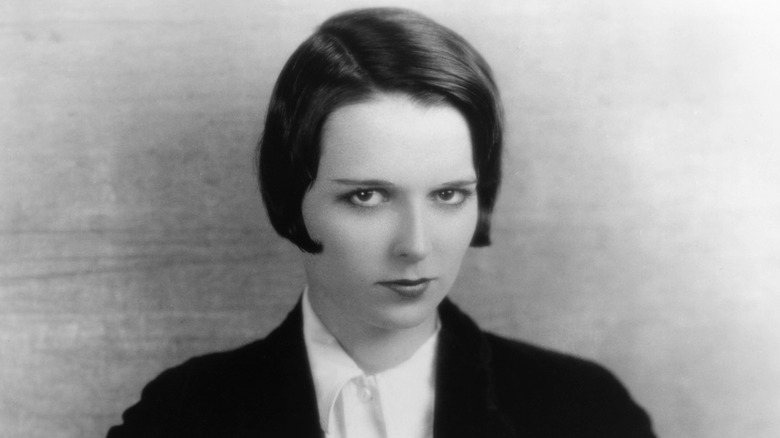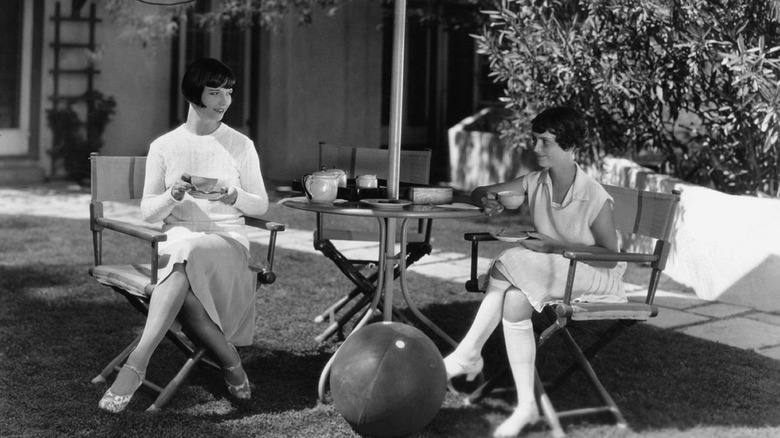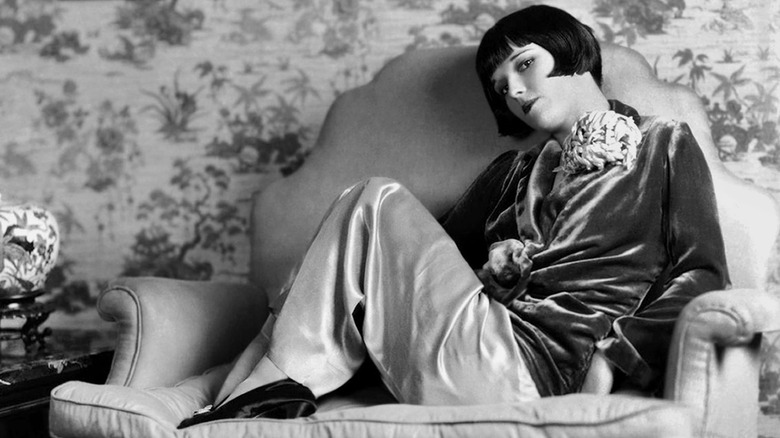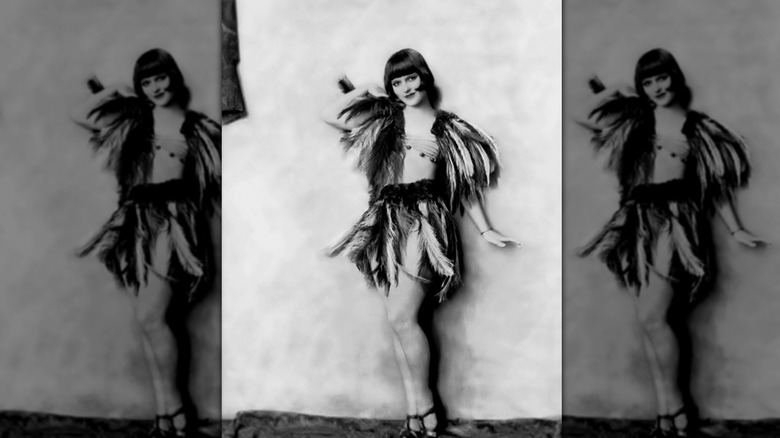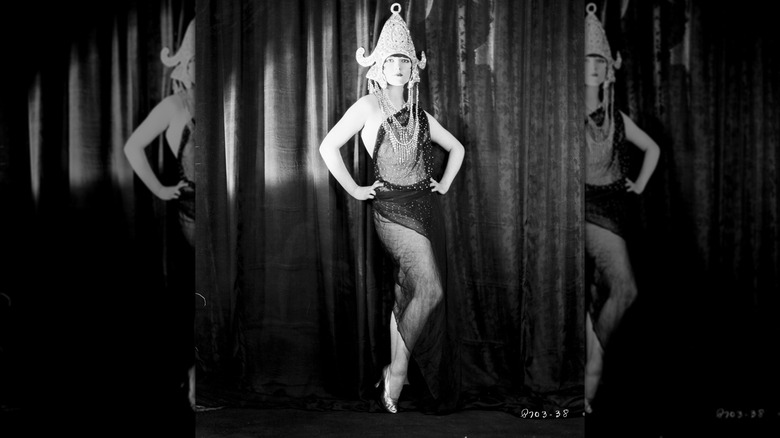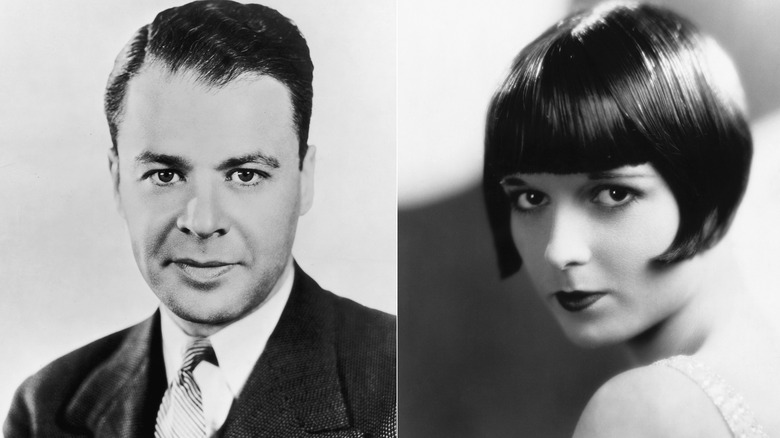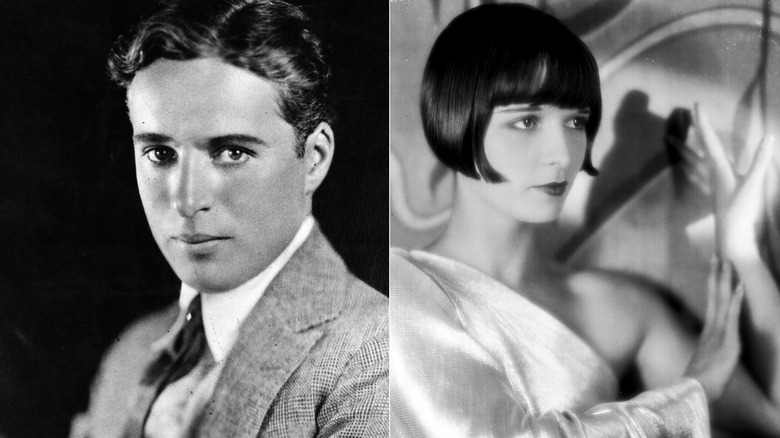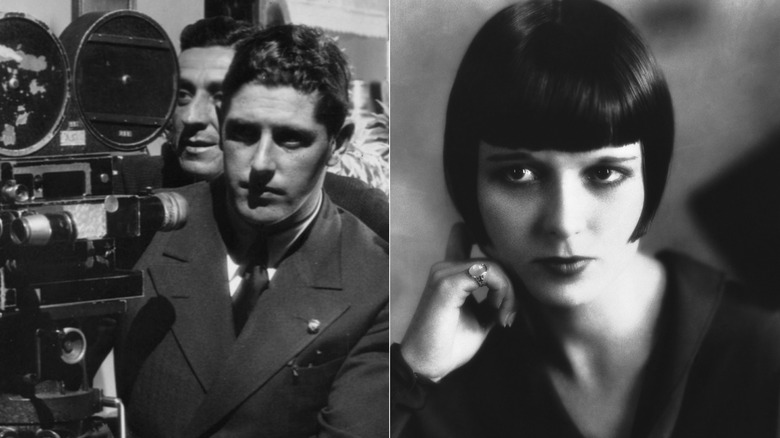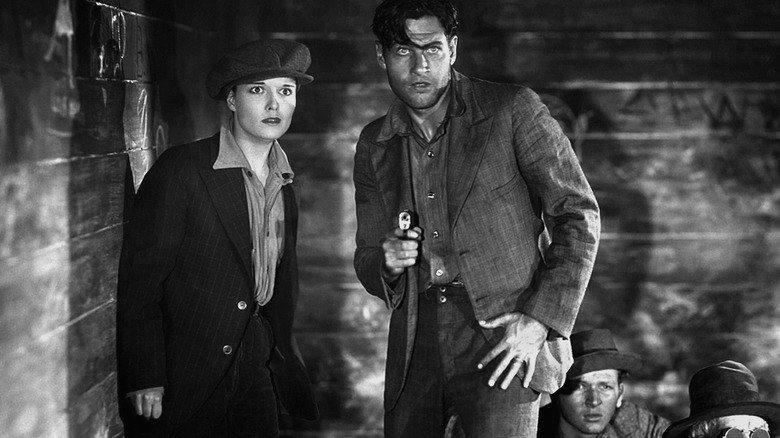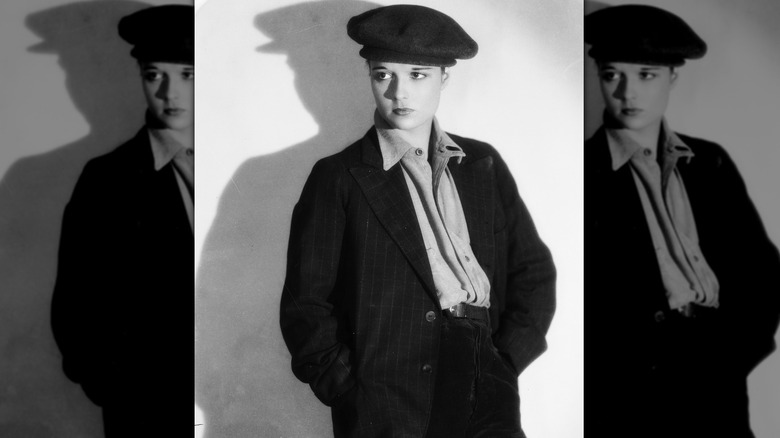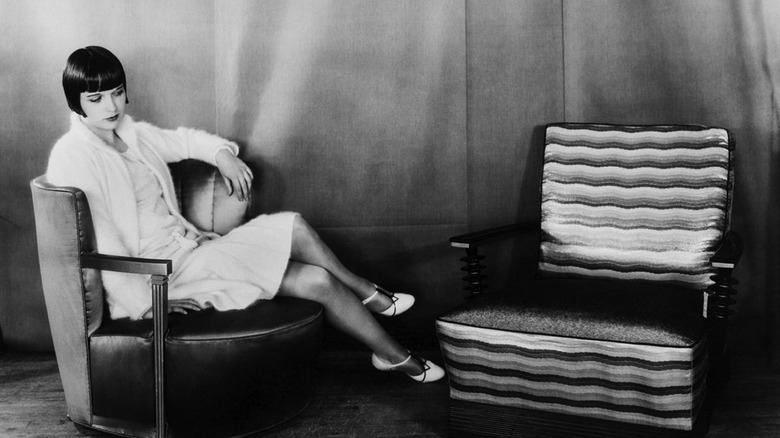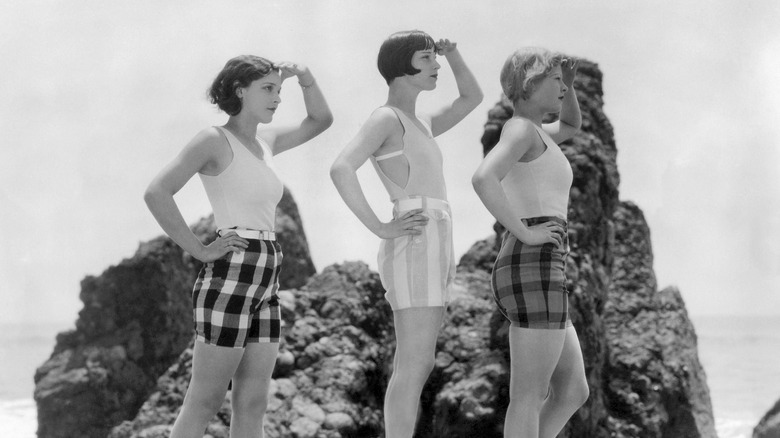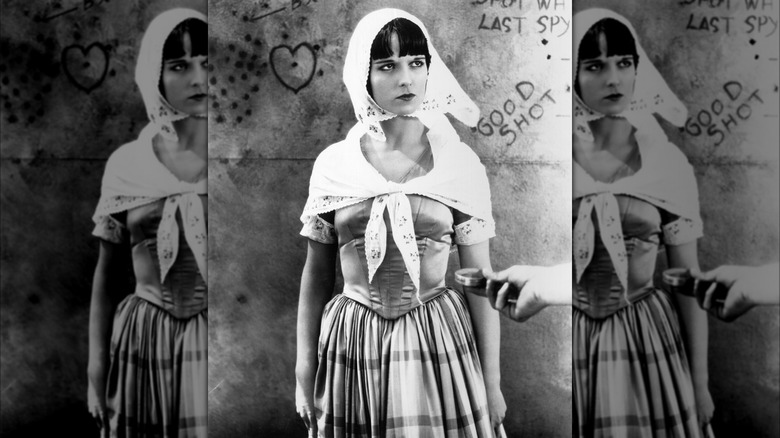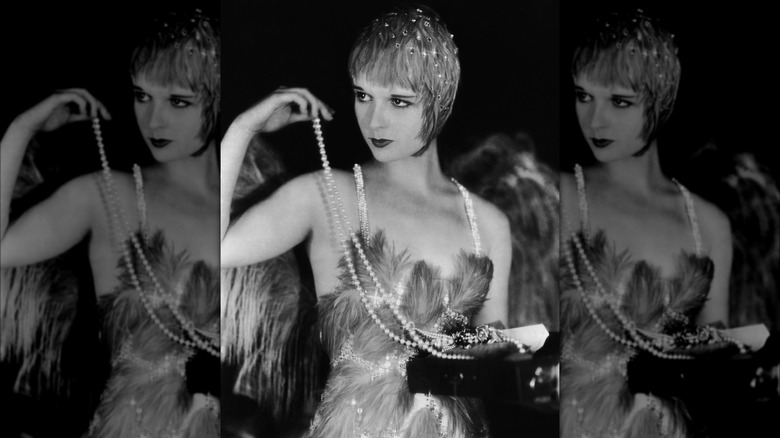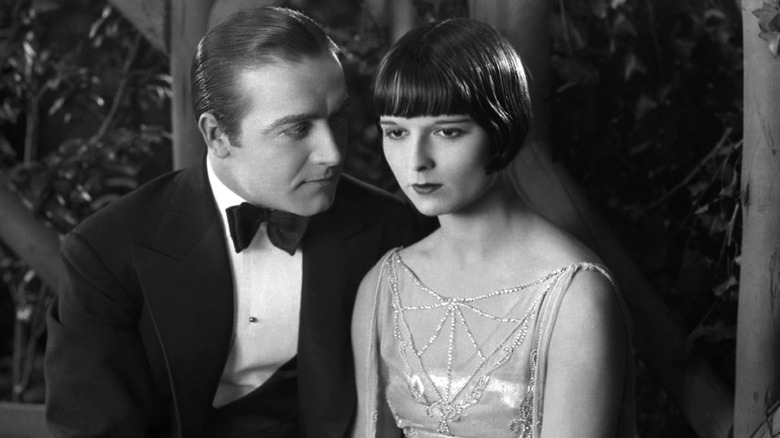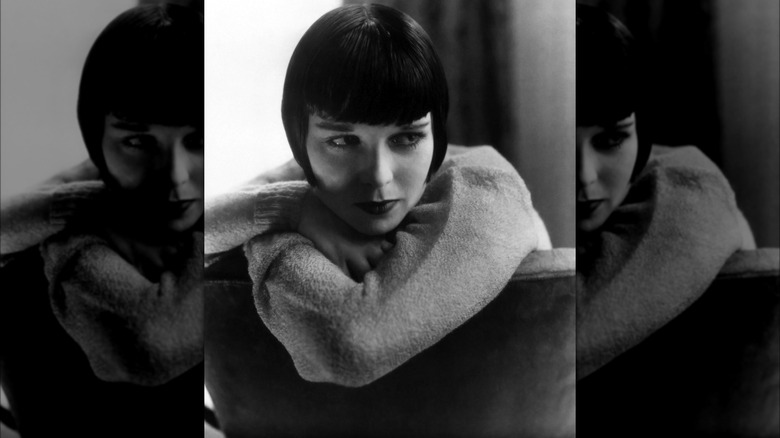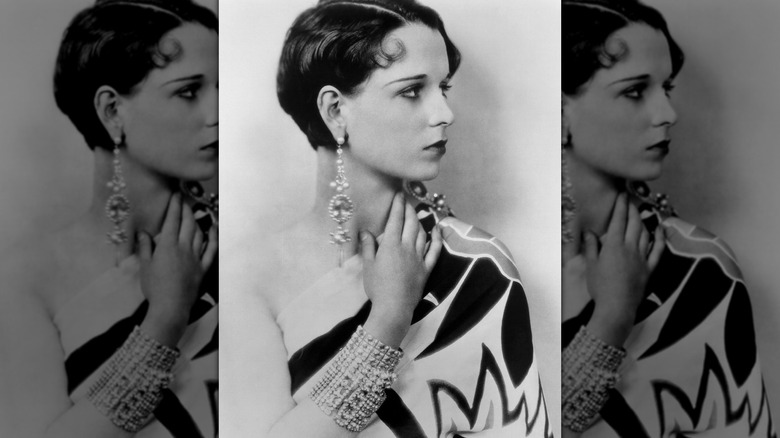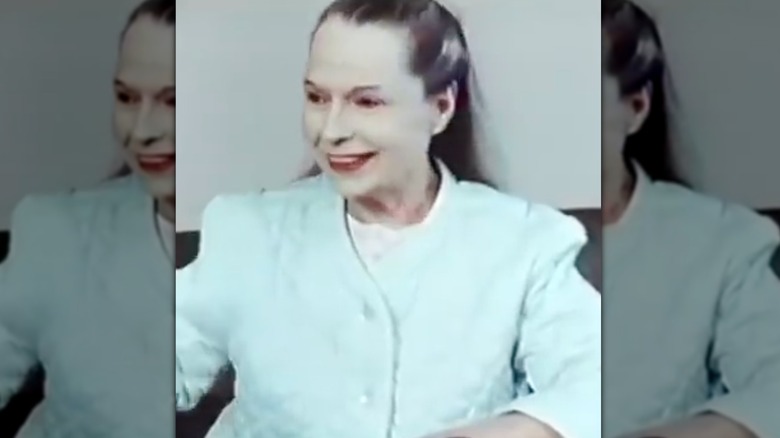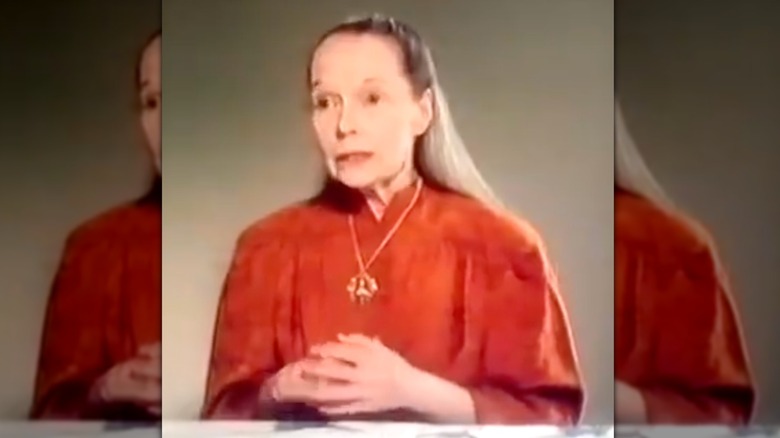Tragic Details About Louise Brooks' Life
This article contains mentions of child abuse and suicide.
There's nothing more beneficial for a star's legacy than an iconic haircut, and Louise Brooks is case study No. 1. The silent film actor stormed her way through Hollywood rocking an instantly-recognizable sleek, "raven" black bob. Her bold look made her one of Tinseltown's go-to "vamps" — aka a smoky-eyed seductress who lured boys next door to their demise.
Although Brooks' resume is resplendent with rich, complicated female roles, like that of Lulu in her most well-known flick "Pandora's Box," today she is most vividly remembered as the ultimate Hollywood drop out. Her strong personality and blunt manner made Brooks the worst nightmare of male studio bosses everywhere, resulting in her saying "goodbye to all that" and leaving Hollywood for good in 1938. However, behind the bravado, this silent screen icon lived a deeply troubled life. Let's take a look back at Brooks' complicated life and study its more hidden details.
Louise Brooks' mother had no time for squalling brats
The fast life of Louise Brooks would end up being ocean's away from her quiet beginnings in the small town of Cherryvale, Kansas. The screen actor was born to a wealthy family on November 14, 1906, where she was the second of four children. Throughout her memoir "Lulu in Hollywood," an older Brooks reflects on her childhood and admits that, despite their financial security, hers was an emotionally distant household.
In one heart-breaking section, Brooks recalls how her mother, Myra Rude, "was forced to sacrifice her girlhood" to take care of her younger siblings. As a result, when she bore her own children, any drop of maternal warmth had already been squeezed out of the woman. "When she married," Brooks writes, "she told Father ... that any squalling brats she produced could take care of themselves. And that is what happened."
A neighbor sexually abused Louise Brooks as a child
In 1979, The New Yorker published an interview with the then-retired screen star. Louise Brooks gave journalist Kenneth Tynan
an unparalleled look into her life, including some of her darkest chapters.
During the interview, Brooks recalls the moment she tragically remembered that she had been sexually molested by her neighbor. It was a repressed memory, but in 1952, an old friend from Kansas mailed Brooks some old photos. One showed a young Brooks holding the hand of an "old bachelor" named Mr. Feathers.
According to Brooks, "That picture brought back something I'd blacked out of my mind for—what?—thirty-seven years. When I was nine years old, Mr. Feathers molested me sexually." She then says, "I've often wondered what effect Mr. Feathers had on my life. He must have had a great deal to do with forming my attitude toward sexual pleasure."
A rivalry ruined Louise Brooks' dance career
One of the little-known facts about Louise Brooks' career is that she started out as a dancer. Unlike many of her contemporaries, who honed their acting skills on Broadway, Brooks cultivated her on-stage charisma in a pair of dancing shoes, which she first picked up when she was 10 years old.
It was dance that took her all the way from Kansas to the big apple and eventually landed her a gig with the Denishawn dance company. However, one of its co-founders, Ruth St. Denis, harbored a deep jealousy for the young ingénue. According to biographer Barry Paris, their rivalry came to a head when St. Denis publicly, and cruelly, fired Brooks in front of the rest of the troupe. Her dance career would never fully recover, with Brooks leaving the world of prestige dance to become a semi-nude dancer at the Ziegfeld Follies.
Louise Brooks' nude photos were sold without her consent
Following her fall from grace at the Denishawn School of Dancing, Louise Brooks' career took a more adult turn. While working as a showgirl in New York City, primarily with the Ziegfeld Follies, Brooks decided to make extra money on the side by posing in the nude for photographer John De Mirjian.
Unfortunately, after Brooks signed her film contract, Mirjian sold the photos for wider publication, resulting in a tabloid scandal. Brooks tried to shut the whole thing down by suing Mirjian, but in a tale as old as time, this only served to draw more attention to the photos. The Daily Mirror at the time published the story under the headline, "Follies girl, now in films, shocked by own pictures." The reporter quotes Brooks as saying, "I intend to be married eventually ... I wish the widespread distribution of those photographs discontinued."
Walter Wanger was ashamed of his affair with Louise Brooks
Louise Brooks met Hollywood power player Walter Wanger while working as a dancer with the Ziegfeld Follies. The producer not only saw star potential in Brooks, but he also saw a future romance.
Though Wanger was already married, he and Brooks soon began an affair. While theirs was a genuine affection, Brooks also knew how to network, and with a well-connected businessman like Wanger at her side, it wasn't long before Brooks was being offered not one but two contracts from different movie studios. However, as her star began to rise, her romance with Wanger began to fizzle. Brooks' lover pleaded with her to stay far away from the studio that signed his pay checks: Paramount Pictures.
Wanger worried that having his girlfriend wandering around the same studio lot he called home would bring too much attention to their secret affair, and as a high-profile man in the early 1900s, appearing faithful to one's wife was integral in keeping a squeaky-clean reputation. Despite him trying to sacrifice her career ambitions, Brooks denied her lover's ardent requests and signed with Paramount.
Louise Brooks never got over her affair with Charlie Chaplin
In the summer of 1925, Louise Brooks had a summer fling with Hollywood legend Charlie Chaplin. The comedian was visiting New York for the premiere of his film "The Gold Rush" when he met the then-dancer at a cocktail party. Although Chaplin was twice Brooks' age — who was only 18-years-old at the time — the two hit it off.
Later in life, Brooks would tell The New Yorker that Chaplin was a "sophisticated lover." However, the publication of her ex-lover's autobiography in 1966 had Brooks quickly changing her tune. In a series of letters to friends, she wrote, "Oh, the book has made me ill. His sex pride! His intellectual fatuity! All those babes knocking on his bedroom door. He still tries to pass off a crude bunch of lies to a world who would not know the difference" (via Stars and Letters).
Louise Brooks' first marriage ended in divorce
Learning how to handle the emotional stress of a divorce can be one of life's most difficult trials, and none knew it as well as screen legend Louise Brooks. Although she was something of a man-eater in her day, enjoying affairs with Hollywood power players like Walter Wanger and comedy god Charlie Chaplin, it was the film director A. Edward Sutherland who finally convinced her to say "I do."
Unlike in the fairy tales, though, walking down the aisle only brought more trials into Brooks' life. From the get-go, the pair seemed doomed to fall apart. Brooks was a certified jazz baby who loved the nightlife while Sutherland had a drinking problem, with neither of them ready to settle down. They both carried on multiple affairs throughout their short-lived union. Only two years after their nuptials in 1926, Brooks filed for divorce.
Louise Brooks was a victim of Hollywood gossip
It can be difficult to discern the differences between a toxic friend and a good friend. Throw in millions of dollars and tabloid attention and your interpersonal drama might just prove to be the stuff of nightmares. That was certainly what Louise Brooks discovered when she made a name for herself in Hollywood.
It wasn't just the pressure of fame that came to make Hollywood a living hell for the actor. The catty culture of the city that saw reputations made and broken by a single whisper at a cocktail party came to be too much for Brooks. She illustrated this in her memoir "Lulu in Hollywood" when she mentions a dalliance with a man following a weekend party. "By Monday morning, everybody in Hollywood ... knew that I had spent the night with Jack Pickford," she wrote.
Rumors of her love affairs had reached such a fever pitch that by the time she made it to the film set of "Beggars of Life," even her co-star, Richard Arlen, made his distaste known. Brooks wrote that Arlen's "winning smile concealed a strong dislike for me," intimating that Arlen's dislike stemmed from the fact that he found her husband, who she had been cheating on, to be a "swell guy."
A movie stunt almost killed Louise Brooks
While today it's common knowledge that there are many celebs who suffer from anxiety and other complex disorders, attitudes toward mental health were not as accepting in Louise Brooks' day as they are today. If they had been, the star may have been diagnosed with something akin to PTSD following a near-fatal incident on the set of "Beggars of Life."
The movie was set to be a big one for Brooks, however, this breakthrough came with a price. Following the story of a woman who disguises herself as a man in order to ride the rails, "Beggars of Life" involved stunt work with trains. In her memoir "Lulu in Hollywood," Brooks recalls a moment when the director convinced her to step in for her stunt double, during which "a fast-moving boxcar ... nearly sucked me under its wheels."
Louise Brooks lost her closest friend to suicide
If you're looking for signs that someone is really your friend, dedicating a whole chapter of their memoir to you might be the brightest green flag. For all her faults, Louise Brooks passed this friendship test when she dedicated a portion of "Lulu in Hollywood" to her departed best friend Pepi Lederer. In fact, the loss of Lederer might just be the greatest loss of Brooks' life.
The socialite was the niece of Marion Davies, the long-time girlfriend of newspaper magnate William Randolph Hearst. Their power and influence loomed large over Lederer's life, with Davies and her partner eventually committing Lederer to a mental hospital for "a drug cure," according to Brooks. However, Brooks hints that the real reason may have been Lederer's openly lesbian lifestyle. Not long after, Lederer leapt from the hospital window, tragically ending her life.
Louise Brooks was blacklisted by Hollywood
If Google had existed in the late 1920s, chances are that "Signs You Need To Quit Your Job" would be at the top of Louise Brooks' search history. Despite her raucous success in Hollywood, the screen icon was made miserable by studio politics. In her memoir "Lulu in Hollywood," Brooks wrote that "there was no other occupation in the world that so closely resembled enslavement."
As silent films fell out of fashion and "talkies" became all the rage, negotiations between Brooks and Paramount Pictures fell apart. The actor had thrived in the previous era, but Brooks refused to play ball when it came to this new landscape of movie-making — specifically, she refused to take the pay cut that Paramount insisted. As a response, she was blacklisted. As Brooks writes in her memoir, "No major studio would hire me to make a film."
In 1932, Louise Brooks declared bankruptcy
After Hollywood, Louise Brooks surprisingly had a successful turn in the European market. It was with Austrian director G.W. Pabst that she made her legacy-defining turn in the film "Pandora's Box," where she plays the enigmatic and seductive Lulu — the character that inspired the name of her eventual memoir.
Following this streak of good luck and great performances in Europe, Brooks tried to make a return to Hollywood, but this would prove to be the final nail in her career coffin. The bad blood that existed between Brooks and the studio bosses before her departure for Europe still existed when she returned, and no casting director would sign her to a contract. In 1932, with no acting gigs coming in, the former icon of the screen officially declared bankruptcy and was forced to return to dancing to make financial ends meet.
Louise Brooks wasn't welcomed back home
After a whirlwind career in Hollywood, Louise Brooks fell on hard times. She attempted to make it work as a dancer in New York City, but her career on the stage also wasn't what it used to be. With the debt collector knocking on her door, Brooks finally decided to move back to her home state of Kansas and attempted to start over in Wichita, where her family had since relocated.
However, Brooks soon found out that Kansas was no longer where she belonged. "That turned out to be another kind of hell," Brooks told The New Yorker in 1979. "The citizens of Wichita either resented me for having been a success or despised me for being a failure. And I wasn't exactly enchanted with them." With Brooks being a verifiable outcast in Kansas, she returned to New York City once again in 1943.
Louise Brooks found work at an escort agency
Having burned all her bridges in Hollywood and having been virtually run out of Wichita, Louise Brooks landed in New York, where she resorted to sex work. Specifically, the former star found that working as an escort was the easiest way of making sure her rent was paid on time.
She attempted several times to carve out a new career path — first as a radio actor, then a gossip columnist, and even at one point as a cashier. However, it was escorting that became Brooks' most reliable form of income. Her clients were mostly wealthy men who easily fell prey to her charming ways that Brooks had picked up during her time hobnobbing with the rich and famous in the film circuit. Tragically, though sex work brought some financial stability to her once-chaotic life, it also caused Brooks much mental turmoil.
Louise Brooks thought about taking her own life
After dreaming of becoming one of the Hollywood greats and having been kicked out of the Eden that was film society's inner-circle, Louise Brooks began to spiral into a depression. Her new life as a sex worker in New York City was defined by loneliness, desire, and a bitterness toward her past friends and colleagues who had since abandoned her.
She admitted in her memoir "Lulu in Hollywood" that though she "thought that getting away from [Hollywood] would automatically cure me of its pestiferous disease," depression still dogged her. Brooks even had at one time contemplated taking her own life, writing, "I found that the only well-paying career open to me, as an unsuccessful actress of thirty-six, was that of a call girl ... and began to flirt with fancies related to little bottles filled with yellow sleeping pills," Brooks wrote.
Louise Brooks' first memoir was destroyed
Between Britney Spears' revealing memoir "The Woman in Me" in 2023 and the startling revelations from Prince Harry's "Spare" the same year, celebrity memoirs have recently become all the rage. Louise Brooks could have added her name to this illustrious list of public figures who raked in the cash with their tell-alls, as she was working on her own memoir for a time. However, tragedy struck before this manuscript could reach a publisher's desk.
The body of writing that eventually did make its way onto bookshelves in 1982 was "Lulu in Hollywood," a collection of essays that intermixed Brooks' own personal drama with her psychological evaluations of other tortured stars of the 1920s and '30s. However, it has long been reported that Brooks' first attempt at a memoir disgusted her so intensely that she threw it in the incinerator, never letting those initial meditations see the light of day.
Old age saw Louise Brooks living as a recluse
In her scathing collection of essays "Lulu in Hollywood," Louise Brooks self-identifies as a "loner." The former silent film actor writes that one of her "most precious rights" now as a woman in her 70s is her "periods of aloneness." "To a film star, on the other hand," she writes, "to be let alone for an instant is terrifying. It is the first signpost on the road to oblivion."
This poetic section of her memoir illustrates just how far removed from her former life Brooks became. By the time film historians began to rediscover her work and praise Brooks' talents, the then-elderly star was living in near-complete solitude in a small flat in upstate New York in the town of Rochester. With no family of her own, this former jazz baby was discovered to be living the life of a hermit.
Louise Brooks never experienced love
An interview with The New Yorker in 1979 saw Louise Brooks reflecting on her past love affairs. Although the former actor was married twice and even had a short-lived affair with Charlie Chaplin, old age revealed to her that none of these dalliances were experiences of true love.
"As a matter of fact, I've never been in love," she told the outlet. "And if I had loved a man, could I have been faithful to him? I doubt it." Although her words prove that with age has come great self-awareness, this admittance of a loveless life exposes the hollowness at the center of Brooks' whirlwind years in both Hollywood and beyond. Only six years after this interview, Brooks died in her home, alone.
If you or anyone you know has been a victim of sexual assault, help is available. Visit the Rape, Abuse & Incest National Network website or contact RAINN's National Helpline at 1-800-656-HOPE (4673).
If you or someone you know is struggling or in crisis, help is available. Call or text 988 or chat 988lifeline.org
